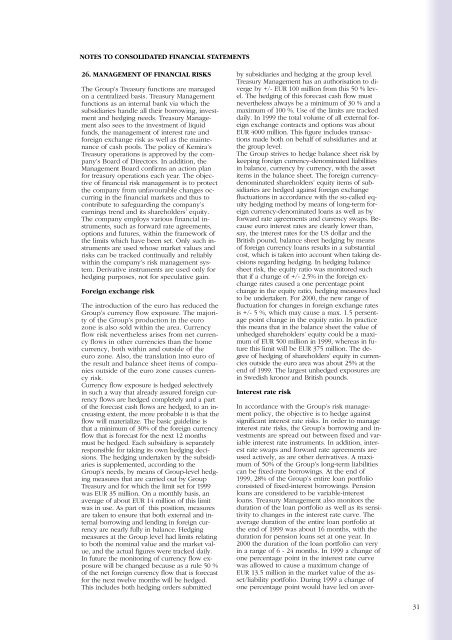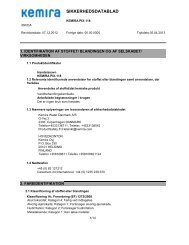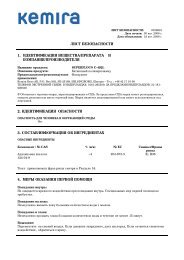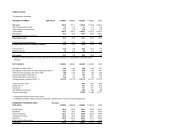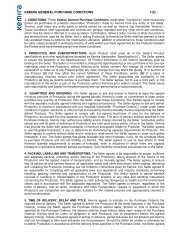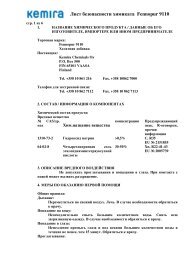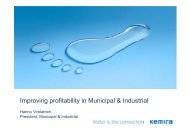Annual Report 1999 - Kemira
Annual Report 1999 - Kemira
Annual Report 1999 - Kemira
Create successful ePaper yourself
Turn your PDF publications into a flip-book with our unique Google optimized e-Paper software.
NOTES TO CONSOLIDATED FINANCIAL STATEMENTS<br />
26. MANAGEMENT OF FINANCIAL RISKS<br />
The Group’s Treasury functions are managed<br />
on a centralized basis. Treasury Management<br />
functions as an internal bank via which the<br />
subsidiaries handle all their borrowing, investment<br />
and hedging needs. Treasury Management<br />
also sees to the investment of liquid<br />
funds, the management of interest rate and<br />
foreign exchange risk as well as the maintenance<br />
of cash pools. The policy of <strong>Kemira</strong>’s<br />
Treasury operations is approved by the company’s<br />
Board of Directors. In addition, the<br />
Management Board confirms an action plan<br />
for treasury operations each year. The objective<br />
of financial risk management is to protect<br />
the company from unfavourable changes occurring<br />
in the financial markets and thus to<br />
contribute to safeguarding the company’s<br />
earnings trend and its shareholders’ equity.<br />
The company employs various financial instruments,<br />
such as forward rate agreements,<br />
options and futures, within the framework of<br />
the limits which have been set. Only such instruments<br />
are used whose market values and<br />
risks can be tracked continually and reliably<br />
within the company’s risk management system.<br />
Derivative instruments are used only for<br />
hedging purposes, not for speculative gain.<br />
Foreign exchange risk<br />
The introduction of the euro has reduced the<br />
Group’s currency flow exposure. The majority<br />
of the Group’s production in the euro<br />
zone is also sold within the area. Currency<br />
flow risk nevertheless arises from net currency<br />
flows in other currencies than the home<br />
currency, both within and outside of the<br />
euro zone. Also, the translation into euro of<br />
the result and balance sheet items of companies<br />
outside of the euro zone causes currency<br />
risk.<br />
Currency flow exposure is hedged selectively<br />
in such a way that already assured foreign currency<br />
flows are hedged completely and a part<br />
of the forecast cash flows are hedged, to an increasing<br />
extent, the more probable it is that the<br />
flow will materialize. The basic guideline is<br />
that a minimum of 30% of the foreign currency<br />
flow that is forecast for the next 12 months<br />
must be hedged. Each subsidiary is separately<br />
responsible for taking its own hedging decisions.<br />
The hedging undertaken by the subsidiaries<br />
is supplemented, according to the<br />
Group’s needs, by means of Group-level hedging<br />
measures that are carried out by Group<br />
Treasury and for which the limit set for <strong>1999</strong><br />
was EUR 35 million. On a monthly basis, an<br />
average of about EUR 14 million of this limit<br />
was in use. As part of this position, measures<br />
are taken to ensure that both external and internal<br />
borrowing and lending in foreign currency<br />
are nearly fully in balance. Hedging<br />
measures at the Group level had limits relating<br />
to both the nominal value and the market value,<br />
and the actual figures were tracked daily.<br />
In future the monitoring of currency flow exposure<br />
will be changed because as a rule 50 %<br />
of the net foreign currency flow that is forecast<br />
for the next twelve months will be hedged.<br />
This includes both hedging orders submitted<br />
by subsidiaries and hedging at the group level.<br />
Treasury Management has an authorisation to diverge<br />
by +/- EUR 100 million from this 50 % level.<br />
The hedging of this forecast cash flow must<br />
nevertheless always be a minimum of 30 % and a<br />
maximum of 100 %. Use of the limits are tracked<br />
daily. In <strong>1999</strong> the total volume of all external foreign<br />
exchange contracts and options was about<br />
EUR 4000 million. This figure includes transactions<br />
made both on behalf of subsidiaries and at<br />
the group level.<br />
The Group strives to hedge balance sheet risk by<br />
keeping foreign currency-denominated liabilities<br />
in balance, currency by currency, with the asset<br />
items in the balance sheet. The foreign currencydenominated<br />
shareholders’ equity items of subsidiaries<br />
are hedged against foreign exchange<br />
fluctuations in accordance with the so-called equity<br />
hedging method by means of long-term foreign<br />
currency-denominated loans as well as by<br />
forward rate agreements and currency swaps. Because<br />
euro interest rates are clearly lower than,<br />
say, the interest rates for the US dollar and the<br />
British pound, balance sheet hedging by means<br />
of foreign currency loans results in a substantial<br />
cost, which is taken into account when taking decisions<br />
regarding hedging. In hedging balance<br />
sheet risk, the equity ratio was monitored such<br />
that if a change of +/- 2.5% in the foreign exchange<br />
rates caused a one percentage point<br />
change in the equity ratio, hedging measures had<br />
to be undertaken. For 2000, the new range of<br />
fluctuation for changes in foreign exchange rates<br />
is +/- 5 %, which may cause a max. 1.5 persentage<br />
point change in the equity ratio. In practice<br />
this means that in the balance sheet the value of<br />
unhedged shareholders’ equity could be a maximum<br />
of EUR 500 million in <strong>1999</strong>, whereas in future<br />
this limit will be EUR 375 million. The degree<br />
of hedging of shareholders’ equity in currencies<br />
outside the euro area was about 25% at the<br />
end of <strong>1999</strong>. The largest unhedged exposures are<br />
in Swedish kronor and British pounds.<br />
Interest rate risk<br />
In accordance with the Group’s risk management<br />
policy, the objective is to hedge against<br />
significant interest rate risks. In order to manage<br />
interest rate risks, the Group’s borrowing and investments<br />
are spread out between fixed and variable<br />
interest rate instruments. In addition, interest<br />
rate swaps and forward rate agreements are<br />
used actively, as are other derivatives. A maximum<br />
of 50% of the Group’s long-term liabilities<br />
can be fixed-rate borrowings. At the end of<br />
<strong>1999</strong>, 28% of the Group’s entire loan portfolio<br />
consisted of fixed-interest borrowings. Pension<br />
loans are considered to be variable-interest<br />
loans. Treasury Management also monitors the<br />
duration of the loan portfolio as well as its sensitivity<br />
to changes in the interest rate curve. The<br />
average duration of the entire loan portfolio at<br />
the end of <strong>1999</strong> was about 16 months, with the<br />
duration for pension loans set at one year. In<br />
2000 the duration of the loan portfolio can very<br />
in a range of 6 - 24 months. In <strong>1999</strong> a change of<br />
one percentage point in the interest rate curve<br />
was allowed to cause a maximum change of<br />
EUR 13.5 million in the market value of the asset/liability<br />
portfolio. During <strong>1999</strong> a change of<br />
one percentage point would have led on aver-<br />
31


